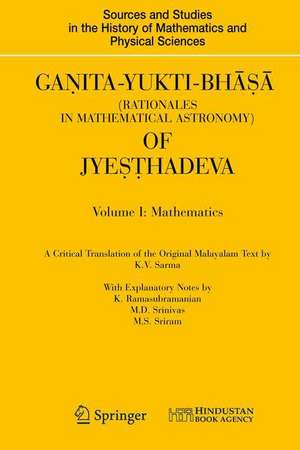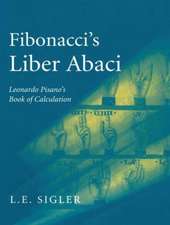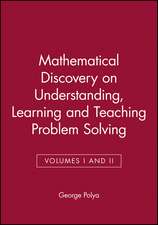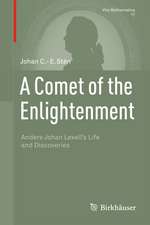Ganita-Yukti-Bhāṣā (Rationales in Mathematical Astronomy) of Jyeṣṭhadeva: Volume I: Mathematics Volume II: Astronomy: Sources and Studies in the History of Mathematics and Physical Sciences
Autor K.V. Sarma, K. Ramasubramanian, M. D. Srinivas, M. S. Sriramen Limba Engleză Hardback – 15 ian 2009
Din seria Sources and Studies in the History of Mathematics and Physical Sciences
- 20%
 Preț: 756.13 lei
Preț: 756.13 lei - 18%
 Preț: 907.11 lei
Preț: 907.11 lei - 15%
 Preț: 667.86 lei
Preț: 667.86 lei -
 Preț: 387.75 lei
Preț: 387.75 lei - 15%
 Preț: 638.57 lei
Preț: 638.57 lei - 18%
 Preț: 896.70 lei
Preț: 896.70 lei - 15%
 Preț: 643.65 lei
Preț: 643.65 lei - 18%
 Preț: 916.25 lei
Preț: 916.25 lei - 18%
 Preț: 1124.92 lei
Preț: 1124.92 lei - 18%
 Preț: 963.29 lei
Preț: 963.29 lei - 15%
 Preț: 652.31 lei
Preț: 652.31 lei - 18%
 Preț: 1244.89 lei
Preț: 1244.89 lei - 23%
 Preț: 686.57 lei
Preț: 686.57 lei - 15%
 Preț: 649.71 lei
Preț: 649.71 lei -
 Preț: 390.25 lei
Preț: 390.25 lei - 15%
 Preț: 644.18 lei
Preț: 644.18 lei - 15%
 Preț: 580.17 lei
Preț: 580.17 lei - 18%
 Preț: 1123.35 lei
Preț: 1123.35 lei - 15%
 Preț: 641.03 lei
Preț: 641.03 lei - 15%
 Preț: 581.14 lei
Preț: 581.14 lei - 18%
 Preț: 796.31 lei
Preț: 796.31 lei - 18%
 Preț: 2119.49 lei
Preț: 2119.49 lei - 24%
 Preț: 860.16 lei
Preț: 860.16 lei - 15%
 Preț: 645.14 lei
Preț: 645.14 lei -
 Preț: 384.48 lei
Preț: 384.48 lei - 18%
 Preț: 1410.63 lei
Preț: 1410.63 lei - 18%
 Preț: 969.28 lei
Preț: 969.28 lei - 15%
 Preț: 642.03 lei
Preț: 642.03 lei - 18%
 Preț: 1113.71 lei
Preț: 1113.71 lei - 15%
 Preț: 662.16 lei
Preț: 662.16 lei - 18%
 Preț: 963.29 lei
Preț: 963.29 lei - 15%
 Preț: 647.59 lei
Preț: 647.59 lei -
 Preț: 395.63 lei
Preț: 395.63 lei - 18%
 Preț: 941.50 lei
Preț: 941.50 lei - 15%
 Preț: 709.56 lei
Preț: 709.56 lei - 18%
 Preț: 901.26 lei
Preț: 901.26 lei - 15%
 Preț: 695.53 lei
Preț: 695.53 lei - 24%
 Preț: 1294.90 lei
Preț: 1294.90 lei
Preț: 1434.29 lei
Preț vechi: 1749.13 lei
-18% Nou
Puncte Express: 2151
Preț estimativ în valută:
274.44€ • 287.32$ • 227.09£
274.44€ • 287.32$ • 227.09£
Carte disponibilă
Livrare economică 15-29 martie
Preluare comenzi: 021 569.72.76
Specificații
ISBN-13: 9781848820722
ISBN-10: 1848820720
Pagini: 1084
Ilustrații: LXVIII, 1084 p. In 2 volumes, not available separately.
Dimensiuni: 155 x 235 x 74 mm
Greutate: 1.97 kg
Ediția:2008
Editura: SPRINGER LONDON
Colecția Springer
Seria Sources and Studies in the History of Mathematics and Physical Sciences
Locul publicării:London, United Kingdom
ISBN-10: 1848820720
Pagini: 1084
Ilustrații: LXVIII, 1084 p. In 2 volumes, not available separately.
Dimensiuni: 155 x 235 x 74 mm
Greutate: 1.97 kg
Ediția:2008
Editura: SPRINGER LONDON
Colecția Springer
Seria Sources and Studies in the History of Mathematics and Physical Sciences
Locul publicării:London, United Kingdom
Public țintă
ResearchCuprins
Volume I: The Eight Mathematical Operations; The Ten Questions and Answers; Arithmetics of Fractions; Rule of Three; Kuttakara; Circle and Circumference; Derivation of Sines.Volume II: Computation of True Planets; Earth and Celestial Spheres; The Fifteen Problems; Gnomonic Shadow; Eclipse; Vyatipata; Maudhya and Visibility Corrections of Planets.
Recenzii
From the reviews:
"The book under review contains an edition and English translation with explanatory notes of the Ganita-yukti-bhasa … . The explanatory notes supplied … elucidate the theories and algorithms in the text in a very helpful way by means of modern equations and diagrams. … a number of appendixes and other additional chapters which make it even more useful. … All in all, this is a very useful publication which makes an important … source of Indian mathematics and astronomy accessible to a wide audience." (Benno van Dalen, Zentralblatt MATH, Vol. 1160, 2009)
"In addition to Sarma’s translation of the GYB, Ramasubramanian, Srinivas and Sriram provide extensive and invaluable explanatory notes on Jyesthadeva’s derivations … . Volume I (Mathematics) will be of the greatest interest to the mathematical community, and is well worth inclusion in any library … oriented towards undergraduate teaching. … it functions as rich and accessible collection of primary-source material for undergraduate classes in the history of mathematics. … Volume II (Astronomy) is recommended for any collection in the history of mathematics … ." (Homer S. White, The Mathematical Association of America, July, 2009)
“The work accomplished by the editors in issuing the mathematical and astronomical parts of the Ganitayuktibhāsa must be applauded. … one can easily understand how Jyesthadeva approximates the circumference of a circle first by constructing a polygon of an uncountable number of sides, then by using power approximations of sines. One can also learn how he computes the mean and true motions of Mercury, and the area of a cyclic quadrilateral, etc. All is thoroughly explained with comprehensive drawings and tables.” (Agathe Keller, Journal for the History of Astronomy, May, 2010)
“The book under review Ganita-yukti bhāsā (Rationales in mathematical astronomy) of Jyesthadeva … rightly fulfils a longunmet need. GYB provides a systematic exposition of the contributions of the Kerala school and is published in two volumes. … This two volume set is a rare and valuable addition to the literature on the history of mathematics.” (Hansraj Joshi, Mathematical Reviews, Issue 2011 b)
"The book under review contains an edition and English translation with explanatory notes of the Ganita-yukti-bhasa … . The explanatory notes supplied … elucidate the theories and algorithms in the text in a very helpful way by means of modern equations and diagrams. … a number of appendixes and other additional chapters which make it even more useful. … All in all, this is a very useful publication which makes an important … source of Indian mathematics and astronomy accessible to a wide audience." (Benno van Dalen, Zentralblatt MATH, Vol. 1160, 2009)
"In addition to Sarma’s translation of the GYB, Ramasubramanian, Srinivas and Sriram provide extensive and invaluable explanatory notes on Jyesthadeva’s derivations … . Volume I (Mathematics) will be of the greatest interest to the mathematical community, and is well worth inclusion in any library … oriented towards undergraduate teaching. … it functions as rich and accessible collection of primary-source material for undergraduate classes in the history of mathematics. … Volume II (Astronomy) is recommended for any collection in the history of mathematics … ." (Homer S. White, The Mathematical Association of America, July, 2009)
“The work accomplished by the editors in issuing the mathematical and astronomical parts of the Ganitayuktibhāsa must be applauded. … one can easily understand how Jyesthadeva approximates the circumference of a circle first by constructing a polygon of an uncountable number of sides, then by using power approximations of sines. One can also learn how he computes the mean and true motions of Mercury, and the area of a cyclic quadrilateral, etc. All is thoroughly explained with comprehensive drawings and tables.” (Agathe Keller, Journal for the History of Astronomy, May, 2010)
“The book under review Ganita-yukti bhāsā (Rationales in mathematical astronomy) of Jyesthadeva … rightly fulfils a longunmet need. GYB provides a systematic exposition of the contributions of the Kerala school and is published in two volumes. … This two volume set is a rare and valuable addition to the literature on the history of mathematics.” (Hansraj Joshi, Mathematical Reviews, Issue 2011 b)
Textul de pe ultima copertă
Ganita-yukti-bhasa (Rationales in Mathematical Astronomy) of Jyesthadeva (c.1530) is a seminal text of the Kerala school of astronomy. It is composed in the Malayalam language and presents detailed yuktis or explanations and demonstrations for the results and processes of mathematical astronomy. The text, comprising fifteen chapters, is naturally divided into two parts, mathematics and astronomy, and purports to give an exposition of the techniques and theories employed in the computation of planetary motions as set forth in the great treatise Tantrasangraha (c.1500) of Nilakantha Somayaji. Even though the importance of Ganita-yukti-bhasa was brought to the attention of modern scholarship by C.M Whish in the 1830s, a critical edition of the entire Malayalam text is published here for the first time along with an English translation and detailed explanatory notes.
The mathematics part is divided into seven chapters. The topics covered are Parikarma (logistics), Dasaprasna (ten problems), Bhinnaganita (fractions), Trairasika (rule of three), Kuttakara (linear indeterminate equations), Paridhi and Vyasa (infinite series and approximations for the ratio of the circumference and diameter of a circle) and Jyanayana (infinite series and approximations for sines). A distinguishing feature of the work is that it presents detailed demonstrations of the famous results attributed to Madhava (c.1340-1420), such as infinite series for p, the arc-tangent and the sine functions, and the estimation of correction terms and their use in the generation of faster convergent series. Demonstrations are also presented for some of the classical results of Aryabhata (c.499) on Kuttakara or the process of solution of linear indeterminate equations, of Brahmagupta (c.628) on the diagonals and the area of a cyclic quadrilateral, and of Bhaskara (c.1150) on the surface area and volume of a sphere.
The astronomy part is divided into eight chapters. The topics covered are Grahagati (computation of mean and true longitudes of planets), Bhugola and Bhagola (Earth and celestial spheres), Pancadasa-prasna (fifteen problems relating to ascension, declination, longitude, etc.), Chaya-ganita (determination of time, place, direction, etc., from gnomonic shadow), Grahana (eclipses), Vyatipata (when the sun and moon have the same declination), Darsana-samskara (visibility correction for planets) and Candra-srngonnati (phases of the moon). A distinguishing feature of this work is that it gives a detailed exposition of the revised planetary model proposed by Nilakantha which, for the first time in the history of astronomy, gives the correct formulation of the equation of centre and the latitudinal motion of the interior planets, Mercury and Venus. Another unique feature of Ganita-yukti-bhasa is that it presents systematic derivations of most of the results of spherical astronomy (pertaining to diurnal and shadow problems, parallax, eclipses, and so on) that are discussed in Indian astronomy.
The work will be of interest to historians of mathematics and astronomy and to philosophers of science.
The mathematics part is divided into seven chapters. The topics covered are Parikarma (logistics), Dasaprasna (ten problems), Bhinnaganita (fractions), Trairasika (rule of three), Kuttakara (linear indeterminate equations), Paridhi and Vyasa (infinite series and approximations for the ratio of the circumference and diameter of a circle) and Jyanayana (infinite series and approximations for sines). A distinguishing feature of the work is that it presents detailed demonstrations of the famous results attributed to Madhava (c.1340-1420), such as infinite series for p, the arc-tangent and the sine functions, and the estimation of correction terms and their use in the generation of faster convergent series. Demonstrations are also presented for some of the classical results of Aryabhata (c.499) on Kuttakara or the process of solution of linear indeterminate equations, of Brahmagupta (c.628) on the diagonals and the area of a cyclic quadrilateral, and of Bhaskara (c.1150) on the surface area and volume of a sphere.
The astronomy part is divided into eight chapters. The topics covered are Grahagati (computation of mean and true longitudes of planets), Bhugola and Bhagola (Earth and celestial spheres), Pancadasa-prasna (fifteen problems relating to ascension, declination, longitude, etc.), Chaya-ganita (determination of time, place, direction, etc., from gnomonic shadow), Grahana (eclipses), Vyatipata (when the sun and moon have the same declination), Darsana-samskara (visibility correction for planets) and Candra-srngonnati (phases of the moon). A distinguishing feature of this work is that it gives a detailed exposition of the revised planetary model proposed by Nilakantha which, for the first time in the history of astronomy, gives the correct formulation of the equation of centre and the latitudinal motion of the interior planets, Mercury and Venus. Another unique feature of Ganita-yukti-bhasa is that it presents systematic derivations of most of the results of spherical astronomy (pertaining to diurnal and shadow problems, parallax, eclipses, and so on) that are discussed in Indian astronomy.
The work will be of interest to historians of mathematics and astronomy and to philosophers of science.
Caracteristici
A long-awaited translation of one of the most important - and hitherto least accessible - works in Indian mathematics, supplemented by detailed explanatory notes and commentary


















